Japanese
English
- 有料閲覧
- Abstract 文献概要
- 1ページ目 Look Inside
はじめに
Waardenburg症候群は1951年,オランダの眼科医であるWaardenburgにより初めて報告された1)。本症候群は,1)内眼角側方偏位,2)鼻根部の拡大,3)両側眉毛の合流,4)前頭部白髪,5)部分的または全虹彩異色症,6)先天性聾または難聴の6つの項目を様々な割合で含んだ,常染色体優性遺伝の形式をとる疾患である。現在では内眼角の側方偏位のあるものをⅠ型(WS1),ないものをⅡ型(WS2)とし,Ⅰ型の症状に上肢の異常をもつものをⅢ型(WS3)としている13)。本症候群は先天性難聴をきたす遺伝性疾患として知られているが,本邦では約30例7)と比較的報告例は少ない。今回われわれはWaardenburg症候群Ⅱ型の1症例を経験したので文献的考察を加え報告する。
Waardenburg syndrome (WS) is an autosomal dominant disorder characterized by pigmentary abnormalities, sensorineural deafness and distinc-tive facial features. Waardenburg syndrome is a relatively popular hereditary disease in the western countries and more than 1000 cases have been reported. On the other hand, this syndrome is rare in Japan and few reports with otological examinations have been found.
Waardenburg syndrome type Ⅱ was found in a 6 -year-old boy who had bilateral sensorineural hear-ing loss and left complete heterochonia iridum. Audiological findings suggested cochlear hearing loss. Strial dysfunction might cause deafness in Waardenburg syndrome.

Copyright © 1997, Igaku-Shoin Ltd. All rights reserved.


